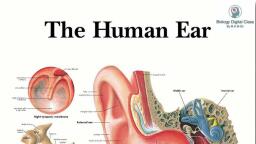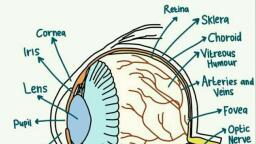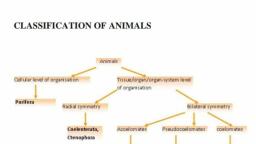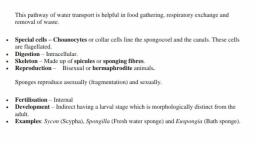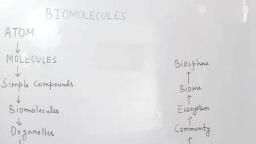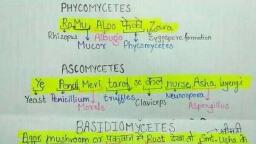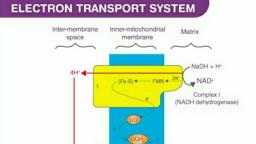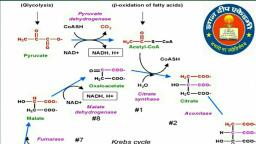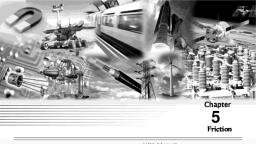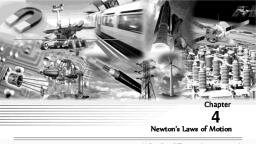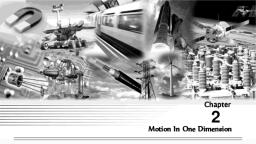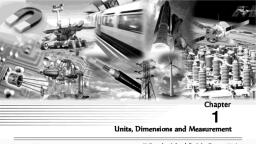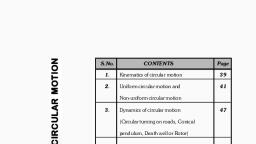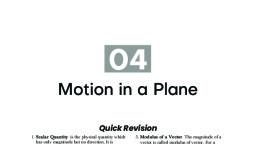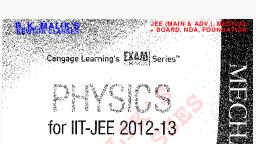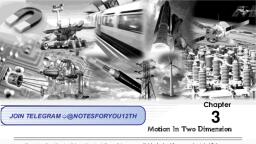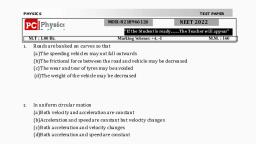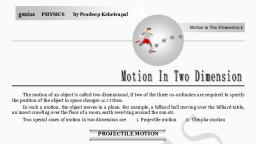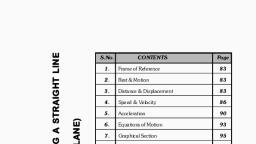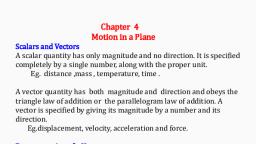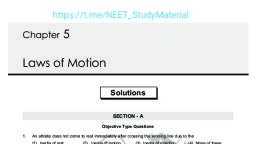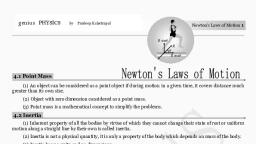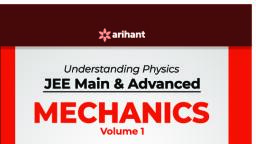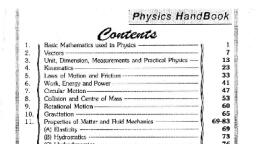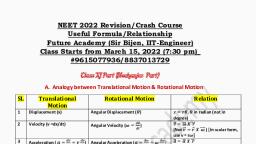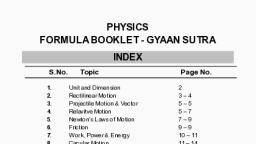Page 1 :
Motion in Two Dimension, , 125, , Chapter, , 3, , Motion In Two Dimension, The motion of an object is called two dimensional, if two of the, three co-ordinates required to specify the position of the object in space,, change w.r.t time., , (i) A bomb released from an aeroplane in level flight, , In such a motion, the object moves in a plane. For example, a, billiard ball moving over the billiard table, an insect crawling over the, floor of a room, earth revolving around the sun etc., , (iv) A Javelin thrown by an athlete, , (ii) A bullet fired from a gun, (iii) An arrow released from bow, , Assumptions of Projectile Motion, , Two special cases of motion in two dimension are, , (1) There is no resistance due to air., , 1. Projectile motion, , (2) The effect due to curvature of earth is negligible., , 2. Circular motion, , (3) The effect due to rotation of earth is negligible., , Introduction of Projectile Motion, A hunter aims his gun and fires a bullet directly towards a, monkey sitting on a distant tree. If the monkey remains in his position,, he will be safe but at the instant the bullet leaves the barrel of gun, if, the monkey drops from the tree, the bullet will hit the monkey because, the bullet will not follow the linear path., , (4) For all points of the trajectory, the acceleration due to gravity ‘ g’, is constant in magnitude and direction., , Principle of Physical Independence of Motions, (1) The motion of a projectile is a two-dimensional motion. So, it can, be discussed in two parts. Horizontal motion and vertical motion. These two, motions take place independent of each other. This is called the principle of, physical independence of motions., (2) The velocity of the particle can be resolved into two mutually, perpendicular components. Horizontal component and vertical component., (3) The horizontal component remains unchanged throughout the, flight. The force of gravity continuously affects the vertical component., (4) The horizontal motion is a uniform motion and the vertical motion is, a uniformly accelerated or retarded motion., , Types of Projectile Motion, The path of motion of a bullet will be parabolic and this motion of, bullet is defined as projectile motion., Fig : 3.1, , (1) Oblique projectile motion, (2) Horizontal projectile motion, (3) Projectile motion on an inclined plane, , If the force acting on a particle is oblique with initial velocity then the, motion of particle is called projectile motion., , Projectile, , X, , Y, , A body which is in flight through the atmosphere under the effect of, gravity alone and is not being propelled by any fuel is called projectile., , Example:, , , , X, Y, Y, X, ,
Page 2 :
126 Motion in Two Dimension, , r xˆi yˆj, , …(i), , The horizontal distance covered during time t is given as, x v x t x u cos t, , …(ii), , The vertical velocity of the particle at time t is given as, v y (v 0 )y gt,, , Oblique Projectile, In projectile motion, horizontal component of velocity (u cos),, acceleration (g) and mechanical energy remains constant while, speed,, velocity, vertical component of velocity (u sin ), momentum, kinetic energy, and potential energy all changes. Velocity, and KE are maximum at the point, of projection while minimum (but not zero) at highest point., (1) Equation of trajectory : A projectile is thrown with velocity u at, an angle with the horizontal. The velocity u can be resolved into two, rectangular components., , …(iii), , Now the vertical displacement y is given as, y u sin t 1 / 2 gt 2, , …(iv), , Putting the values of x and y from equation (ii) and equation (iv) in, equation (i) we obtain the position vector at any time t as, , 1, , , r (u cos ) t ˆi (u sin ) t gt 2 ˆj, 2, , , , , r (u t cos )2 (u t sin ) , , , Y, , 1 2, gt , 2, , , 2, , 2, , u sin , , gt sin, gt , r ut 1 , and tan 1 (y / x ), 2, u, u, , , P, , x, u, , y, , O u cos , , X, Fig : 3.3, , v cos component along X–axis and u sin component along Y–, axis., For horizontal motion x = u cos t t , y (u sin ) t , , For vertical motion, , Note, , x, … (i), u cos , , 1 2, gt, 2, , 1 2, , ut sin gt , , , 2, or tan 1 2u sin gt , tan, , , (u t cos ) , 2u cos , , , , , 1 , , y x tan , , 1 , x2, g , 2, 2, , 2 u cos , , …(ii), , tan , , , , , , , Y, , , , 2, , 1, gx, 2 u 2 cos 2 , , 2, , :, , 1, tan , 2, , u, , This equation shows that the trajectory of projectile is parabolic, because it is similar to equation of parabola, y = ax – bx, , Note, , The angle of elevation of the highest, , point of the projectile and the angle of projection are related to each, other as, , From equation (i) and (ii), x, y u sin , u cos , , : , , Equation of oblique projectile also can be, , written as, , H, , (3) Instantaneous velocity, v : In projectile motion, X vertical, O, R, component of velocity changes but horizontal component of velocity, Fig : 3.5, remains always constant., Example : When a man jumps over the hurdle leaving behind its, skateboard then vertical component of his velocity is changing, but not the, horizontal component which matches with the skateboard velocity., As a result, the skateboard stays underneath him, allowing him to land on, it., , x, u 2 sin 2, , y x tan 1 (where R = horizontal range =, ), R, g, , , (2) Displacement of projectile ( r ) : Let the particle acquires a, position P having the coordinates (x, y) just after time t from the instant of, , , , projection. The corresponding position vector of the particle at time t is r, as shown in the figure., , Fig : 3.6, , Y, , i, , P (x, y), , , v, , , r, , y, , , O, , Let v be the instantaneous velocity of projectile at time t, direction, of this velocity is along the tangent to the trajectory at point P., , vi v x i v y ˆj v i v x2 v y2, , , , vx, , , , , vy, , , , x, Fig : 3.4, , , vx, , X, vi
Page 3 :
(ii) For complementary angles of projection and 90 – , , u 2 cos 2 (u sin gt)2, , o, , (a) Ratio of time of flight =, , v i u 2 g 2 t 2 2u gt sin, , Direction of instantaneous velocity tan , , , tan 1 tan , , or, , , , vy, vx, , , , T1, tan , T2, , = tan , , u sin gt, u cos, , T1, 2u sin / g, , T2 2u sin(90 ) / g, , (b) Multiplication of time of flight = T1 T2 , , gt, , sec , u, , , (4) Change in velocity : Initial velocity (at projection point), u i u cos ˆi u sin ˆj, Final velocity (at highest point) u f u cos ˆi 0 ˆj, , (i) Change in velocity (Between projection point and highest point), , T1 T2 , , 2R, g, , (iii) If t is the time taken by projectile to rise upto point p and t is, the time taken in falling from point p to ground level then, 2, , t1 t 2 , , 2u sin, time of flight or, g, , , u u f u i u sin ˆj, , u sin , , Y, 1, , h, , (ii) Change in momentum (For the complete projectile motion), , p p f p i 2mu sin ˆj, (6) Angular momentum : Angular momentum of projectile at, highest point of trajectory about the point of projection is given by, , u 2 sin2 , Here r H , , 2g , , , L mvr, , , , L m u cos, , 3, , 2, , R u cos T, u cos (2u sin / g), , , , r, , , X, Fig : 3.7, , (7) Time of flight : The total time taken by the projectile to go up, and come down to the same level from which it was projected is called time, of flight., For vertical upward motion 0 = u sin – gt, Now as time taken to go up is equal to the time taken to come, down so, 2u sin, g, , (i) Time of flight can also be expressed as : T , the vertical component of initial velocity)., , u, , , u 2 sin 2, R, g, , O, , g, , (where u is, y, , X, Horizontal range, Fig : 3.10, , (i) Range of projectile can also be expressed as :, , , , 2u sin, g, , 2 u cos u sin 2u x u y, , g, g, , R, , 2 .u y, , Y, , u 2 sin 2, g, , R = u cos × T = u cos , , t = (u sin /g), , Time of flight T 2 t , , g t1 t 2, 2, (iv) If B and C are at the same level on trajectory and the time, difference between these two points, Y, is t , similarly A and D are also at, the same level and the time, t1, difference between these two, h, B, C, t, 2, positions is t then, A, D, 8h, 2, 2, O, t 2 t1 , X, Fig : 3.9, g, , by solving h , , 2, , P = mv, , O, , (t1 t 2 ), 1, t1 gt12, 2, 2, , (8) Horizontal range : It is the horizontal distance travelled by a, body during the time of flight., So by using second equation of motion in x-direction, , 2, , Y, , u, , hg, , 1 2, gt 1, 2, , 1, , m u cos sin , u sin , , 2g, 2g, 2, , Fig : 3.8, , and height of the point p is given by h u sin t1 , , , u u f u i 2u sin î, , (i) Change in momentum (Between projection point and highest, , point) p p f p i mu sin ˆj, , t2, X, , O, , (ii) Change in velocity (Between complete projectile motion), , g(t 1 t 2 ), 2, , P, , t1, , When body reaches the ground after completing its motion then, final velocity u f u cos ˆi u sin ˆj, , (5) Change in momentum : Simply by the multiplication of mass in the, above expression of velocity (Article-4)., , 2u sin 2u cos, g, g, , 2u xuy, , (where u and u are the horizontal and vertical, g, component of initial velocity), x, , y, , (ii) If angle of projection is changed from to = (90 – ) then, range remains unchanged., , 60o, 30o, , Blast
Page 4 :
128 Motion in Two Dimension, tan [4 / n] or tan 1[4 / n], The angle of projection is given by tan 1 [4 / n], , Note, , If R = H then tan 1 (4 ) or 76 o ., , :, , If R = 4H then tan 1 (1) or 45 o ., (9) Maximum height : It is the maximum height from the point of, projection, a projectile can reach., Y, , So, by using v 2 u 2 2as, 0 (u sin )2 2 gH, u 2 sin 2 ', u 2 sin[2(90 o )] u 2 sin 2, , , R, g, g, g, , H, , So a projectile has same range at angles of projection and (90 –, ), though time of flight, maximum height and trajectories are different., These angles and 90 – are called complementary angles of, projection and for complementary angles of projection, ratio of range, , H , , 1, , 2, , 2, , and are also the complementary angles., 1, , (where u y is the vertical component of initial velocity)., , 2g, , =, , , o, , R = (u /g), 2, , max, , i.e., a projectile will have maximum range when it is projected at an, angle of 45 to the horizontal and the maximum range will be (u /g)., When the range is maximum, the height H reached by the projectile, o, , 2, , 2, , o, , H1, u 2 sin2 / 2 g, sin2 , 2, , tan 2 , H 2 u sin2 (90 o ) / 2 g, cos 2 , , H1, tan 2 , H2, , (10) Projectile passing through two different points on same height, at time t and t : If the particle passes two points situated at equal height y, at t t 1 and t t2 , then, 1, , 2, , (i) Height (y): y u sin t1 , , Y, , H, , …(i), , 1 2, gt2, 2, , …(ii), , Y, , 45o, , O, , 1 2, gt1, 2, , y u sin t 2 , , and, , u, , H, , u2, (when sin = max = 1 i.e., = 90 ), 2g, , i.e., for maximum height body should be projected vertically upward., So it falls back to the point of projection after reaching the maximum, height., , d u 2 sin 2 , dR, 0 , , 0, d , g, d, , , and, , X, , Fig : 3.13, , o, , (iv) Maximum range : For range to be maximum, , o, , , , (iii) For complementary angles of projection and 90 – , Ratio of maximum height, , 2, , cos 2 = 0 i.e. 2 = 90 = 45, , u y2, , (ii) H max , , (iii) For angle of projection = (45 – ) and = (45 + ), range, will be same and equal to u cos 2/g., , u, , (i) Maximum height can also be expressed, as, O, , o, , R1, R1, u 2 sin 2 / g, 1, 2, 1 , R2, R 2 u sin[2 (90 o )] / g, , u 2 sin2 , 2g, , Max. height, , R' , , R = 4 H2, 2 max, , R, u 2 sin2 u 2 sin 45 u, , , max, Fig : 3.12, 2g, 2g, 4g, 4, , X, t = t1, , u, , i.e., if a person can throw a projectile to a maximum distance R ,, , t = t2, , max, , R, , The maximum height during the flight to which it will rise is max ., 4, , , (v) Relation between horizontal range and maximum height :, , R, , u sin 2, u sin , and H , 2g, g, 2, , , , 2, , 2, , (vi) If in case of projectile motion range R is n times the maximum, height H, , i.e. R = nH , , y, , y, X, , O, , Fig : 3.14, , Comparing equation (i) with equation (ii), g t 1 t 2 , 2, Substituting this value in equation (i), u sin , , R, u 2 sin 2 / g, 2, 4 cot R 4 H cot , H u sin2 / 2 g, , u sin 2, u sin , n, g, 2g, 2, , , , 2, , 2, , t t2, y g 1, 2, , gt t, , 1, t1 gt12 y 1 2, 2, 2, , , (ii) Time (t and t ): y u sin t , 1, , 2, , 1 2, gt, 2
Page 5 :
Motion in Two Dimension, , 2 gy, u sin , 2u sin, 2y, 2, 1 1, t , t, 0 t , , u sin, g , g, g, , , t1 , , , 2 gy, , , 1 1 u sin, , , , , u sin, g, , 1, , 1, , 2, , Y, u1, y1 – y2, B, , X, , Ball A : x = (u cos )t, y 1 (u 1 sin 1 ) t , 1, , Ball B : x = (u cos )t, y 2 (u 2 sin 2 ) t , 2, , 2, , When a body is projected horizontally from a certain height ‘y’, vertically above the ground with initial velocity u. If friction is considered to, be absent, then there is no other horizontal force which can affect the, horizontal motion. The horizontal velocity therefore remains constant and, so the object covers equal distance in horizontal direction in equal intervals, of time., , x = ut t , , 2, , 1 2, gt, 2, , x, u, , 1 2, gt, 2, , y, , x x 1 x 2 (u1 cos 1 u 2 cos 2 ) t, , 1, gt, 2, , 2, , u, , O, , …. (i), , X, , y, , The vertical displacement y is, governed by, , The position of the ball A with respect to ball B is given by, , P(x, y), , x, , …. (ii), , Y, Fig : 3.17, , (since initial vertical velocity is, zero), , y y 1 y 2 (u1 sin 1 u 2 sin 2 ) t, , Now, , 1, mu 2 = Energy at the point of projection., 2, , Horizontal Projectile, , Fig : 3.15, , 1, , =, , This is in accordance with the law of conservation of energy., , The instantaneous positions of the two balls are given by, 1, , 1, 1, mu 2 cos 2 mu 2 sin2 , 2, 2, , (1) Trajectory of horizontal projectile : The horizontal displacement x, is governed by the equation, , u2, O, , , , The horizontal velocity therefore remains constant and so the, object covers equal distance in horizontal direction in equal intervals of, time., , A, , 2, , (iii) Total energy = Kinetic energy + Potential energy, , 2 , , , , , , , 2, , 1, , K sin2 , , 2 , , , , , , , 2 , , 2 gy , u sin , , , and t 2 , 1 1 , , g , u sin , , , , , (11) Motion of a projectile as observed from another projectile :, Suppose two balls A and B are projected simultaneously from the origin,, with initial velocities u and u at angle and , respectively with the, horizontal., , 129, , By substituting the value of t in equation (ii) y , , y u 1 sin 1 u 2 sin 2 , constant, , x u 1 cos 1 u 2 cos 2 , , 1 g x2, 2 u2, , , (2) Displacement of Projectile (r ) : After time t, horizontal displacement, , Thus motion of a projectile relative to another projectile is a straight line., (12) Energy of projectile : When a projectile moves upward its, kinetic energy decreases, potential energy increases but the total energy, always remain constant., If a body is projected, Y, with initial kinetic energy K(=1/2, u cos, mu ), with angle of projection , K = Kcos2, u, with the horizontal then at the, , highest point of trajectory, K, X, (i), Kinetic, energy, Fig : 3.16, 1, 1, m (u cos )2 mu 2 cos 2 , 2, 2, , x ut and vertical displacement y , , 1 2, gt ., 2, , , 1, So, the position vector r ut ˆi gt 2 ˆj, 2, , Therefore, , 2, , gt , r ut 1 , 2u , , 2, , gt , and tan 1 , 2u , , gy , u, 2, , , , , tan 1 , , , as t , , , , 2y, g, , , , , , , (3) Instantaneous velocity : Throughout the motion, the horizontal, component of the velocity is v = u., x, , K ' K cos 2 , , The vertical component of velocity increases with time and is given, , (ii) Potential energy mgH mg, 1, mu 2 sin2 , 2, , by, , u 2 sin2 , 2g, , 2, 2, , As H u sin , , 2g, , , v =0+gt=gt, y, , , , , , , (From v = u + g t), , , So, v v x ˆi v y ˆj = u ˆi g t ˆj
Page 6 :
130 Motion in Two Dimension, gt , u 1 , u , , i.e. v u gt, , 2, , 2, , (i) They strike the ground with same speed at different times, irrespective of their initial direction of velocities., (ii) Time would be least for particle E which was thrown vertically, downward., (iii) Time would be maximum for particle A which was thrown, vertically upward., , 2, , , Again v uˆi 2 gy ˆj, , i.e. v u 2 2 gy, , Projectile Motion on An Inclined Plane, x, u, , O, , , y, , , r, , P (x,y), , vx, , , , v, , vy, , and u u sin ., , Y, , vy, , Fig : 3.18, , Direction of instantaneous velocity : tan , vy, tan 1 , vx, , Let a particle be projected up with a speed u from an inclined, plane which makes an angle with the horizontal and velocity of, projection makes an angle with the inclined plane., We have taken reference x-axis in the direction of plane., Hence the component of initial velocity parallel and perpendicular to, the plane are equal to u cos and u sin respectively i.e. u|| u cos , , X, , 2 gy, , tan 1 , , u, , , , The component of g along the plane is g sin and perpendicular, , vx, , , or tan 1 gt , , u , , , Where is the angle of instantaneous velocity from the horizontal., (4) Time of flight : If a body is projected horizontally from a height, h with velocity u and time taken by the body to reach the ground is T, then, 1, (for vertical motion), h 0 gT 2, 2, T, , to the plane is g cos as shown in the figure i.e. a|| g sin and, a g cos ., , Therefore the particle decelerates at a rate of g sin as it moves, from O to P., (1) Time of flight : We know for oblique projectile motion, 2u, 2u sin, or we can say T , T, g, a, Y, , , u, , 2h, g, , a x=–g sin , , (5) Horizontal range : Let R is the horizontal distance travelled by, the body, 1, R uT 0 T 2 (for horizontal motion), 2, R u, , , , , , , g, , a y= g cos , , O t =0, Fig : 3.21, , Time of flight on an inclined plane T , , 2h, g, , X, , P, t =T, , 2u sin, g cos , , (2) Maximum height : We know for oblique projectile motion, , (6) If projectiles A and B are projected horizontally with different, initial velocity from same height and third particle C is dropped from same, point then, (i) All three particles will take equal time to reach the ground., (ii) Their net velocity would be different but all three particle, possess same vertical component of velocity., (iii) The trajectory of projectiles A and B will be straight line w.r.t., particle C., , H, , u 2 sin2 , 2g, , or we can say H , , u 2, 2a, , Maximum height on an inclined plane H , , u 2 sin2 , 2 g cos , , (3) Horizontal range : For one dimensional motion s ut , Horizontal range on an inclined plane R u|| T , , h, C, , B, , A, , R u cos T , , : 3.19 same initial velocity but in, (7) If various particles thrownFigwith, different direction then, , A, u, , u, A, , B, , u, C, , D, , u, , u, , h, A, , E, Fig : 3.20, , R, , 1, 2u sin, g sin , 2, , g cos , , , , , , 2, , 2u 2 sin cos( ), g, cos 2 , , (i) Maximum range occurs when , , E, , 1, a|| T 2, 2, , 1, g sin T 2, 2, , 2u sin, R u cos , g cos , , By solving, , 1 2, at, 2, , , , , , , 4 2, (ii) The maximum range along the inclined plane when the projectile, is thrown upwards is given by
Page 7 :
Motion in Two Dimension, R max , , u2, g (1 sin ), , (iii) Ratio of distance and displacement :, , (iii) The maximum range along the inclined plane when the, projectile is thrown downwards is given by, R max , , u2, g (1 sin ), , (1) Displacement and distance : When particle moves in a circular, path describing an angle during time t (as shown in the figure) from the, position A to the position B, we see that the magnitude of the position, , , vector r (that is equal to the radius of the circle) remains constant. i.e.,, , r1 r2 r and the direction of the position vector changes from time to, , time., (i) Displacement : The change of position vector or the displacement, , r of the particle from position A to the position B is given by referring, , the figure., , v2, v1, , , r r2 r1 r r r2 r1, B, , , r2, , 2r1r2 cos , , Putting r1 r2 r we obtain, , O, , , , r r 2 r 2 2r.r cos, , r 2r 2 1 cos , , Fig : 3.23, , , r2, , , , 2r 2 2 sin2 , 2, , r 2r sin, , , , O, , , , , r1, , A, , , r, , , r1, , 0, , 0, , (ii) Units = Radian or Degree. It is some time also specified in terms, of fraction or multiple of revolution., (iii) 2 rad 360 o 1 Revolution, (iv) Angular displacement is a axial vector quantity., Its direction depends upon the sense of rotation of the object and, can be given by Right Hand Rule; which states that if the curvature of the, fingers of right hand represents the sense of, rotation of the object, then the thumb, held, S, perpendicular to the curvature of the fingers,, , represents the direction of angular displacement, O, r, vector., (v) Relation between linear displacement, Fig : 3.25, , and angular displacement s r, or s r, , (3) Angular velocity () : Angular velocity of an object in circular, motion is defined as the time rate of change of its angular displacement., (i) Angular velocity =, , , angle traced, d , Lt, , t 0 t, time taken, dt, , d, dt, , (ii) Dimension : [M L T ], 0, , 0, , –1, , (iii) Units : Radians per second (rad.s ) or Degree per second., –1, , (iv) Angular velocity is an axial vector., Its direction is the same as that of . For anticlockwise rotation of, the point object on the circular path, the direction of , according to Right, hand rule is along the axis of circular path directed upwards. For clockwise, rotation of the point object on the circular path, the direction of is along, the axis of circular path directed downwards., (v) Relation between angular velocity and linear velocity v r, , B, , A, , Fig : 3.24, 2, (ii) Distance : The distanced covered by the particle during the time, t is given as, , d = length of the arc AB = r , , cosec ( / 2), , 0, , Variables of Circular Motion, , r , , 2, , (i) Dimension = [M L T ] (as = arc / radius) ., , Circular motion is another example of motion in two dimensions. To, create circular motion in a body it, , must be given some initial velocity and, v2, a force must then act on the body, , v3, which is always directed at right angles, to instantaneous velocity., F, F, Since this force is always at, , F, right angles to the displacement, F, therefore no work is done by the force, , v1, on the particle. Hence, its kinetic, , energy and thus speed is unaffected., v4, But due to simultaneous action of the, Fig : 3.22, force and the velocity the particle, follows resultant path, which in this case is a circle. Circular motion can be, classified into two types – Uniform circular motion and non-uniform, circular motion., , r22, , , , d, r, , r 2r sin / 2, , (2) Angular displacement () : The angle turned by a body moving, in a circle from some reference line is called angular displacement., , Circular Motion, , r12, , , , 131, , (vi) For uniform circular motion remains constant where as for nonuniform motion varies with respect to time., , Note, , :, , It is important to note that nothing actually, , moves in the direction of the angular velocity vector . The direction of, , simply represents that the circular motion is taking place in a plane, perpendicular to it., (4) Change in velocity : We want to know the magnitude and, direction of the change in velocity of the particle which is performing, uniform circular motion as it moves from A to B during time t as shown in, figure. The change in velocity vector is given as
Page 8 :
132 Motion in Two Dimension, , , v v 2 v1, , v2, , , v1, , , v2, , , v1, , T, , , , B, , , O, , , , or, , , , v v 2 v1, , , v 1, , v v12 v 22 2v1v 2 cos, , For uniform circular motion v1 v 2 v, So v 2v 2 1 cos 2v sin, , rel, , , , TT, 2, 1 2, 2 1 T1 T2, , 2 , , as T , , , , maintain their position relative to each other. This is what actually happens, in case of geostationary satellite, ( = = constant), , Fig : 3.27, , Fig : 3.26, , 2, , Special case : If B A , rel 0 and so T = ., particles will, , A, , , v v 2 v1, , with respect to the other (i.e., time in which B completes one more or less, revolution around O than A), , , , 1, , 2, , (7) Angular acceleration () : Angular acceleration of an object in, circular motion is defined as the time rate of change of its angular velocity., (i) If be the change in angular velocity of the object in time, interval t, while moving on a circular path, then angular acceleration of, the object will be, , , 2, , , The direction of v is shown in figure that can be given as, , , , , 180 o , 90 o / 2, 2, , , , (5) Time period (T) : In circular motion, the time period is defined, as the time taken by the object to complete one revolution on its circular, path., (i) Units : second., (ii) Dimension : [M L T], (iii) Time period of second’s hand of watch = 60 second., (iv) Time period of minute’s hand of watch = 60 minute, (v) Time period of hour’s hand of watch = 12 hour, (6) Frequency (n) : In circular motion, the frequency is defined as, the number of revolutions completed by the object on its circular path in a, unit time., (i) Units : s or hertz (Hz)., (ii) Dimension : [M L T ], 0, , 0, , –1, , 0, , Note, , 0, , :, , Relation between angular velocity, frequency and time period :, Consider a point object describing a uniform circular motion with frequency, n and time period T. When the object completes one revolution, the angle, traced at its axis of circular motion is 2 radians. It means, when time t = T,, 2, ( T, 2n, 2 radians. Hence, angular velocity , t, T, = 1/n), 2, 2n, T, , If two particles are moving on same circle or different coplanar, concentric circles in same direction with different uniform angular speeds, and respectively, the angular velocity of B relative to A will be, A, , Lt, , t 0, , d 2, d , 2, , t, dt, dt, , (ii) Units : rad. s, , –2, , (iii) Dimension : [M L T ], 0, , 0, , –2, , (iv) Relation between linear acceleration and angular acceleration, a r, , (v) For uniform circular motion since is constant so, d, , 0, dt, , (vi) For non-uniform circular motion 0, , –1, , Relation between time period and frequency, : If n is the frequency of revolution of an object in circular motion, then the, object completes n revolutions in 1 second. Therefore, the object will, complete one revolution in 1/n second., T 1 / n, , , , Fig : 3.28, , B, , rel B A, So the time taken by one to complete one revolution around O with, respect to the other (i.e., time in which B complete one revolution around O, , Centripetal Acceleration, (1) Acceleration acting on the object undergoing uniform circular, motion is called centripetal acceleration., (2) It always acts on the object along the, v, ac, radius towards the centre of the circular path., (3) Magnitude of centripetal acceleration,, a, , v2, 4 2, 2 r 4 2 n 2 r 2 r, r, T, , Fig : 3.29, , (4) Direction of centripetal acceleration : It is always the same as, , that of . When t decreases, also decreases. Due to which , becomes more and more perpendicular to . When t 0, , becomes perpendicular to the velocity vector. As the velocity vector of the, particle at an instant acts along the tangent to the circular path, therefore, , and hence the centripetal acceleration vector acts along the radius of, the circular path at that point and is directed towards the centre of the, circular path., , Centripetal force, According to Newton's first law of motion, whenever a body moves, in a straight line with uniform velocity, no force is required to maintain this, velocity. But when a body moves along a circular path with uniform speed,, its direction changes continuously i.e. velocity keeps on changing on account
Page 9 :
Motion in Two Dimension, of a change in direction. According to Newton's second law of motion, a, change in the direction of motion of the body can take place only if some, external force acts on the body., Due to inertia, at every point of the circular path; the body tends to, move along the tangent to the circular path, v, at that point (in figure). Since every body has, v, directional inertia, a velocity cannot change, by itself and as such we have to apply a force., But this force should be such that it changes, F, F, F, the direction of velocity and not its, F, magnitude. This is possible only if the force, acts perpendicular to the direction of velocity., Because the velocity is along the tangent, this v, v, force must be along the radius (because the, Fig : 3.30, radius of a circle at any point is perpendicular, to the tangent at that point). Further, as this force is to move the body in a, circular path, it must acts towards the centre. This centre-seeking force is, called the centripetal force., Hence, centripetal force is that force which is required to move a, body in a circular path with uniform speed. The force acts on the body, along the radius and towards centre., , line motion but to observer B it appears that a real force has actually acted, on the body and is responsible for throwing the body radially out-wards., This imaginary force is given a name to explain the effects of inertia to the, observer who is sharing the circular motion of the body. This inertial force, is called centrifugal force. Thus centrifugal force is a fictitious force which, has significance only in a rotating frame of reference., , Work Done by Centripetal Force, The work done by centripetal force is, always zero as it is perpendicular to velocity and, hence instantaneous displacement., , mv 2, m 4 2 r, m 2 r m 4 2 n 2 r , r, T2, , 90o, , Work done = Increment in kinetic energy, of revolving body, , F, , Work done = 0, Also W = F. S = F S cos = FS cos, , Fig : 3.31, , 90 = 0, o, , Example : (i) When an electron revolves around the nucleus in, hydrogen atom in a particular orbit, it neither absorb nor emit any energy, means its energy remains constant., , Skidding of Vehicle on A Level Road, , Table 3.1 : Centripetal force in different situation, Situation, , S, , (ii) When a satellite established once in a orbit around the earth and, it starts revolving with particular speed, then no fuel is required for its, circular motion., , Formulae for centripetal force :, F, , 133, , When a vehicle takes a turn on a circular path it requires centripetal, force., , Centripetal Force, , If friction provides this centripetal force then vehicle can move in, circular path safely if, , A particle tied to a string and, whirled in a horizontal circle, Vehicle taking a turn on a level, road, , Tension in the string, , A vehicle on a speed breaker, , Weight of the body, component of weight, , Revolution of earth around the, sun, Electron revolving around the, nucleus in an atom, , Gravitational force exerted by the, sun, Coulomb attraction exerted by the, protons in the nucleus, , A charged particle describing a, circular path in a magnetic field, , Magnetic force exerted by the, agent that sets up the magnetic, field, , Friction force Required centripetal force, , Frictional force exerted by the, road on the tyres, or, , a, , mg, , mg , , m2r, , mv 2, r, , v safe rg, Fig : 3.32, , Centrifugal Force, It is an imaginary force due to incorporated effects of inertia. When, a body is rotating in a circular path and the centripetal force vanishes, the, body would leave the circular path. To an observer A who is not sharing the, motion along the circular path, the body appears to fly off tangentially at, the point of release. To another observer B, who is sharing the motion along, the circular path (i.e., the observer B is also rotating with the body with the, same velocity), the body appears to be stationary before it is released. When, the body is released, it appears to B, as if it has been thrown off along the, radius away from the centre by some force. In reality no force is actually, seen to act on the body. In absence of any real force the body tends to, continue its motion in a straight line due to its inertia. The observer A, easily relates this events to be due to inertia but since the inertia of both, the observer B and the body is same, the observer B can not relate the, above happening to inertia. When the centripetal force ceases to act on the, body, the body leaves its circular path and continues to move in its straight-, , This is the maximum speed by which vehicle can take a turn on a, circular path of radius r, where coefficient of friction between the road and, tyre is ., , Skidding of Object on A Rotating Platform, On a rotating platform, to avoid the skidding of an object (mass m), placed at a distance r from axis of rotation, the centripetal force should be, provided by force of friction., Centripetal force Force of friction, , m r mg, 2, , max (g / r) ,, Hence maximum angular velocity of rotation of the platform is, (g / r) , so that object will not skid on it., , Bending of A Cyclist
Page 10 :
134 Motion in Two Dimension, A cyclist provides himself the necessary centripetal force by leaning, inward on a horizontal track, while going round a curve. Consider a cyclist, of weight mg taking a turn of radius r with velocity v. In order to provide, the necessary centripetal force, the cyclist leans through angle inwards as, shown in figure., The cyclist is under the action of the following forces :, The weight mg acting vertically downward at the centre of gravity of, cycle and the cyclist., , In the figure (A) shown reaction R is resolved into two components,, the component R cos balances weight of vehicle, R cos mg, , and the horizontal component R sin provides necessary, centripetal force as it is directed towards centre of desired circle, Thus R sin , , The reaction R of the ground on cyclist. It will act along a linemaking angle with the vertical., , …(i), , and R cos = mg, , …(ii), , tan , , R sin , , 2r, g, , , , v, g, , …(iv) [As v = r ], , h h, , x l, , [since is very small], , …(v), , From equation (iii), (iv) and (v), tan , , …(iii), mg, , cyclist, , should, , bend, , through, , an, , 2r v h, v2, , , , rg, g, g, l, , Note, , Fig : 3.33, , the, , …(iii), , If l = width of the road, h = height of the outer edge from the, ground level then from the figure (B), , , , mv2/r, , v2, or tan , rg, , Therefore,, , …(ii), , v2, rg, , or tan , , Dividing equation (i) by (ii), we have, R sin, m v2 r, , R cos , mg, , tan , , R, R cos, , mv 2, r, , Dividing (ii) by (i), we have, , The vertical component R cos of the normal reaction R will balance, the weight of the cyclist, while the horizontal component R sin will, provide the necessary centripetal force to the cyclist., mv 2, R sin , r, , …(i), , angle, , :, , If friction is also present between the tyres, , v, tan , , rg 1 tan , 2, , v2 , , , rg , , and road then, , tan 1 , , It follows that the angle through which cyclist should bend will be, greater, if, (i) The radius of the curve is small i.e. the curve is sharper, (ii) The velocity of the cyclist is large., , Note, , :, , For the same reasons, an ice skater or an, , aeroplane has to bend inwards, while taking a turn., , Banking of A Road, , Maximum safe speed on a banked frictional road, v, , rg( tan ), 1 tan , , Overturning of Vehicle, When a car moves in a circular path with speed more than a certain, maximum speed then it overturns even if friction is sufficient to avoid, skidding and its inner wheel leaves the ground first, , For getting a centripetal force, cyclist bend towards the centre of, circular path but it is not possible in case of four wheelers., Therefore, outer bed of the road is raised so that a vehicle moving, on it gets automatically inclined towards the centre., R cos , , R, , G, , R1, , R2, , h, , , F, , R sin , , , , , mg, , Fig. (A), , 2a, , Weight of the car = mg, mg, Speed of the car = v, Fig : 3.35, Radius of the circular path = r, Distance between the centre of wheels of the car = 2a, Height of the centre of gravity (G) of the car from the road level = h, Reaction on the inner wheel of the car by the ground = R, Reaction on the outer wheel of the car by the ground = R, When a car move in a circular path, horizontal friction force F, provides the required centripetal force, 1, , l, , 2, , h, , , x, Fig. (B), Fig : 3.34
Page 11 :
Motion in Two Dimension, , i.e., F , , 135, , (2) When car moves on a convex bridge, , mv 2, R, , …(i), R, , For rotational equilibrium, by taking the moment of forces R , R and, F about G, 1, , Fh R1a R2 a, , v, , 2, , , mg, , …(ii), , mg cos, , , , As there is no vertical motion so R + R = mg …(iii), 1, , 2, , By solving (i), (ii) and (iii), , Convex bridge, , 1 , v 2h , R1 M g , , 2 , ra , , and R 2 , , …(iv), , and reaction R mg cos , , 1 , v 2h , M g , , 2 , ra , , …(v), , 1, , 1, , v h, g or v , ra, , gra, h, , If the speed of the particle in a horizontal circular motion changes, with respect to time, then its motion is said to be non-uniform circular, motion., Consider a particle describing a circular path of radius r with centre, at O. Let at an instant the particle be at P and be its linear velocity and, , i.e. the maximum speed of a car without overturning on a flat road is given, , be its angular velocity., , , Then,, …(i), r, Differentiating both sides of w.r.t. time t we have, , gra, h, , by v , , , , Motion of Charged Particle In Magnetic Field, When a charged particle having mass m , charge q enters, perpendicularly in a magnetic field B with velocity v then it describes a, circular path., , , , mv 2, r, , radius of the circular path, mv, r, qB, , , , , , , , , , , , , , , , , , , , , , , , , , , , , , , , , , , , , , , , , , , , , , , , , , , , , , , , , , , , , , , , , , , , , , , , , , , , , , , , , , , , F, , Fig : 3.36, , , , dv , a, (Resultant acceleration), dt, , , a r , , Here,, , at, a, , , , , v, , , , , , q, , , , , B, , , , , d, (Angular acceleration), dt, , , , a a t ac, …(iii), , O, , ac, , P, , Fig : 3.39, , , , dr , (Linear velocity), dt, Thus the resultant acceleration of the particle at P has two, component accelerations, , (1) Tangential acceleration : a t r, It acts along the tangent to the circular path at P in the plane of, circular path., , Reaction of Road On Car, , , , When car moves on a concave bridge then, R, , …(ii), , , , Magnetic force = Centripetal force, , (1), , , , d d dr, , r , dt, dt, dt, , Because magnetic force (qvB) works in the perpendicular direction of, v and it provides required centripetal force, , qvB =, , mv 2, r, , Non-Uniform Circular Motion, , It is clear from equation (iv) that if v increases value of R decreases, and for R = 0, 2, , mv 2, r, , Centripetal force = mgFig, cos: 3.38, R , , , , According to right hand rule since and r are perpendicular to, each other, therefore, the magnitude of tangential acceleration is given by, | a t | | r | r sin 90 o r., , , , (2) Centripetal (Radial) acceleration : a c v, , , It is also called centripetal acceleration of the particle at P., It acts along the radius of the particle at P., , v, , mg cos, , mg, , Concave bridge, , Fig : 3.37, , Centripetal force = R mg cos , mv 2, and reaction R mg cos , r, , mv 2, r, , According to right hand rule since and are perpendicular to, each other, therefore, the magnitude of centripetal acceleration is given by, , , | ac | | | sin90 o = ( r) 2 r 2 / r, Table 3.2 : Tangential and centripetal acceleration, Centripetal, acceleration, , Tangential, acceleration, , Net acceleration, , ac = 0, , at = 0, , a=0, , Type of motion, Uniform
Page 12 :
136 Motion in Two Dimension, translatory, motion, , at 0, , ac = 0, , ac 0, , at = 0, , ac 0, , at 0, , Note, , :, , a = at, , Accelerated, translatory, motion, , a = ac, , Uniform, circular motion, Non-uniform, circular motion, , a ac2 at2, , (1) Velocity at any point on vertical loop : If u is the initial velocity, imparted to body at lowest point then velocity of body at height h is given, by, v u 2 2 gh u 2 2 gl(1 cos ), , [As h = l – l cos = l (1 – cos)], where l is the length of the string, C, , Here a governs the magnitude of v while, t, , l, , D, , O, , u, A, : 3.40 loop : Tension at general point, (2) Tension at any point onFig, vertical, , mv 2, mr 2, r, , Centripetal force : Fc ma c , , P, , h, , (3) Force : In non-uniform circular motion the particle, simultaneously possesses two forces, , P, According to Newton’s second law of motion., Net force towards centre = centripetal force, , Tangential force : Ft ma t, , :, , In non-uniform circular motion work done, , by centripetal force will be zero since Fc v, , In non uniform circular motion work done by, tangential force will not be zero since F 0, , or T mg cos , T, , C, , mv 2, l, , T mg cos , , Net force : Fnet ma = m ac2 at2, , Note, , B, v, , , , a c its direction of motion., , mv 2, l, , l, , D, , O, , m 2, [u gl(2 3 cos )], l, , , , A, , [As v u 2 2 gl(1 cos ) ], , B, , T, , P, , , mg cos, + mv2/r, , mg, , Fig : 3.41, , t, , Rate of work done by net force in non-uniform, Table 3.3 : Velocity and tension in a vertical loop, , circular motion = rate of work done by tangential force, dW , i.e. P , Ft .v, dt, , Equations of Circular Motion, For accelerated motion, , For retarded motion, , 2 1 t, , 2 1 t, , Position, , Angle, , Velocity, , Tension, , A, , 0o, , u, , mu 2, mg, l, , B, , 90o, , u 2 2 gl, , mu 2, 2mg, l, , 1, 1t t 2, 2, , 1t , , 1, t2, 2, , C, , 180o, , u 2 4 gl, , mu 2, 5 mg, l, , 22 12 2 , , 22 12 2 , , D, , 270o, , u 2 2 gl, , mu 2, 2mg, l, , n 1 , , , 2, , n 1 , , (2n 1), , , 2, , (2n 1), , It is clear from the table that :, , TA TB TC and T = T, B, , D, , TA TB 3mg,, , Where, , = Initial angular velocity of particle, = Final angular velocity of particle, , = Angular acceleration of particle, = Angle covered by the particle in time t, = Angle covered by the particle in n second, 1, , TA TC 6mg, , and TB TC 3mg, , 2, , th, , n, , Motion in vertical circle, This is an example of non-uniform circular motion. In this motion, body is under the influence of gravity of earth. When body moves from, lowest point to highest point. Its speed decrease and becomes minimum at, highest point. Total mechanical energy of the body remains conserved and, KE converts into PE and vice versa., , Table 3.4 : Various conditions for vertical motion, Velocity at lowest, point, , Condition, , u A 5 gl, , Tension in the string will not be zero at any of the, point and body will continue the circular motion., , u A 5gl ,, , Tension at highest point C will be zero and body will, just complete the circle., , 2 gl u A 5 gl ,, , Particle will not follow circular motion. Tension in, string become zero somewhere between points B and, C whereas velocity remain positive. Particle leaves, circular path and follow parabolic trajectory.
Page 13 :
Motion in Two Dimension, u A 2 gl, , Both velocity and tension in the string becomes zero at, B and particle will oscillate along semi-circular path., , u A 2 gl, , velocity of particle becomes zero between A and B but, tension will not be zero and the particle will oscillate, about the point A., , Note, , :, , K.E. of a body moving in horizontal circle is, , same throughout the path but the K.E. of the body moving in vertical circle, is different at different places., If body of mass m is tied to a string of length l and is, projected with a horizontal velocity u then :, u2, Height at which the velocity vanishes is h , 2g, , Height at which the tension vanishes is h , , 137, , u 2 gl, 3g, , (3) Critical condition for vertical looping : If the tension at C is zero,, then body will just complete revolution in the vertical circle. This state of, body is known as critical state. The speed of body in critical state is called, as critical speed., From the above table 3.3 T =, C, , mu 2, 5 mg 0, l, , u 5 gl, It means to complete the vertical circle the body must be projected, with minimum velocity of, , 5 gl at the lowest point., , Table 3.5 : Different variables in vertical loop, Point A, , Point B, , Point C, , Point D, , 5 gl, , 3 gl, , gl, , 3 gl, , gl (3 2 cos ), , 5g, l, , 3g, l, , g, l, , 3g, l, , g, (3 2 cos ), l, , Tension in String (T), , 6 mg, , 3 mg, , 0, , 3 mg, , 3mg (1 cos ), , Kinetic Energy (KE), , 5, mgl, 2, , 3, mgl, 2, , 1, mgl, 2, , 3, mgl, 2, , mu 2, 5 mg 0, l, , 0, , mgl, , 2 mgl, , mgl, , mgl (1 cos ), , 5, mgl, 2, , 5, mgl, 2, , 5, mgl, 2, , 5, mgl, 2, , 5, mgl, 2, , Quantity, Linear velocity (v), Angular velocity (), , Potential Energy (PE), Total Energy (TE), , (4) Motion of a block on frictionless hemisphere : A small block of mass m, slides down from the top of a frictionless hemisphere of radius r. The component, of the force of gravity (mg cos) provides required centripetal force but at point B, it's circular motion ceases and the block lose contact with the surface of the sphere., , B, , , (r – h ), , h, , , , i.e. the block lose contact at the height of, , r, , 2, r from the ground., 3, , and angle from the vertical can be given by cos , cos 1, , A, , Point P, , h 2, , r 3, , 2, ., 3, , Conical Pendulum, This is the example of uniform circular motion in horizontal plane., , mg, , For point B, by equating theFigforces,, : 3.42, mg cos , , mv 2, r, , …(i), , For point A and B, by law of conservation of energy, , A bob of mass m attached to a light and in-extensible string rotates, in a horizontal circle of radius r with constant angular speed about the, vertical. The string makes angle with vertical and appears tracing the, surface of a cone. So this arrangement is called conical pendulum., The force acting on the bob are tension and weight of the bob., , Total energy at point A = Total energy at point B, From the figure T sin , , K.E. + P.E. = K.E. + P.E., ( A), , 0 + mgr =, , ( A), , ( B), , ( B), , 1, mv 2 mgh v 2 g(r h), 2, , …(ii), , and from the given figure h r cos , , ….(ii), S, , By substituting the value of v and h from eq (ii) and (iii) in eq (i), h m, mg , r r, , 2 g (r h) , 2, , , , n, , h 2 (r h) h , , 2, r, 3, , ….(i), , and T cos mg, , …(iii), n, , mv 2, r, , l, , h, , O, Fig : 3.43, , r, , P
Page 14 :
138 Motion in Two Dimension, (f) Change in the direction of motion , v2 , (1) Tension in the string : T mg 1 , rg , , T, , mg, , cos , , mgl, l r, 2, , 2, , [As cos , , 2, , (ii) On return to the ground, that is in going from O to G, the following, changes take place, (a) Change in speed = zero, l2 r2, ], l, , h, , l, , S, , (b) Change in velocity = 2 u sin, (c) Change in momentum = 2 mu sin, (d) Change in kinetic energy = zero, (e) Change in potential energy = zero, , , , T, , T sin, , (f) Change in the direction of motion = 2, , T cos, , (i) At highest point, the horizontal component of velocity is v =u cos, , , , x, , P, , and vertical component of velocity v is zero., , mv2/r, , O, , y, , (ii) At highest point, linear momentum of a particle, mg, , Fig : 3.44, , (2) Angle of string from the vertical : tan , , 2, , m v = mu cos., , v, rg, , x, , 1, mv x2, 2, , (iii) Kinetic energy of the particle at the highest point =, (3) Linear velocity of the bob : v gr tan , , , (4) Angular velocity of the bob :, , , , g, tan , r, , At highest point, acceleration due to gravity acting vertically, , g, g, , h, l cos , , downward makes an angle of 90° with the horizontal component of the, velocity of the projectile., , (5) Time period of revolution :, TP 2, , 1, mu 2 cos 2 ., 2, , At the highest point, momentum of the projectile thrown at an, , l cos , h, 2, g, g, , angle with horizontal is p cos and K.E. = (K.E.) cos ., 2, , i, , In projectile motion, horizontal component ucos of velocity u, , l2 r2, r, 2, 2, g, g tan , , remains constant throughout, whereas vertical component usin changes, and becomes zero at the highest point., , The trajectory of a projectile is parabolic., For a projectile, time of flight and maximum height depend on the, vertical component of the velocity of projection., , Consider a projectile of mass m thrown with velocity u making, angle with the horizontal. It is projected from the point O and, returns to the ground at G. Also M is the highest point attained by it., (See figure)., , The range of the projectile is maximum for the angle of projection, 45 ., , The maximum range of the projectile is :, R max , , Y, , u2, g, , When the range is maximum, the height attained by the projectile, is :, , M, P (X,Y), , u, , , H, , H, G, , O, R, , X, , R, u2, max, 4g, 4, , When the range of the projectile is maximum, the time of flight is :, , (i) In going from O to M, following changes take place –, T 2t , , (a) Change in velocity u sin, (b) Change in speed u(1 cos ) 2u cos 2 ( /2), (c) Change in momentum mu sin, , 2u, g, , The height attained by a projectile is maximum, when 90 ., u2, 2g, , (d) Change (loss) in kinetic energy 1 / 2 mu sin , , H max , , (e) Change (gain) in potential energy 1 / 2 mu 2 sin2 , , It is twice that of height attained, when the range is maximum., , 2, , 2
Page 15 :
Motion in Two Dimension, , the direction of rotation, then the outstretched thumb gives the direction, , , of , and , , , , and are called pseudo vectors or axial vectors., , The time of flight of the projectile is also largest for 90 ., Tmax , , 2u, g, , For circular motion we have –, , The trajectory of the projectile is a symmetric parabola only when, , , , , (i) r v, (ii) r antiparallel to ac, , , , (iii) ac v, (iv) ac at, , , (v) , , are perpendicular to r , ac , at , v, , , (vi) r , ac , at and v lie in the same plane, , g is constant through out the motion and is not equal to 0°, 90° or, 180°., , If velocity of projection is made n times, the maximum height, attained and the range become n times and the time of flight becomes n, times the initial value., 2, , If the force acting on a particle is always perpendicular to the, velocity of the particle, then the path of the particle is a circle. The, centripetal force is always perpendicular to the velocity of the particle., , If circular motion of the object is uniform, the object will possess, only centripetal acceleration., , If circular motion of the object is non-uniform, the object will, possess both centripetal and transverse acceleration., , When the particle moves along the circular path with constant, speed, the angular velocity is also constant. But linear velocity,, momentum as well as centripetal acceleration change in direction,, although their magnitude remains unchanged., , For circular motion of rigid bodies with uniform speed, the angular, speed is same for all particles, but linear speed varies directly as the, radius of the circular path described by the particle (v r) ., , When a body rotates, all its particles describe circular paths about, a line, called axis of rotation., , The centre of the circle describe by the different particles of the, rotating body lie on the axis of rotation., , Centripetal force F = ma , m 2r where m = mass of the body., Centripetal force is always directed towards the centre of the, c, , c, , circular path., , When a body rotates with uniform velocity, its different particles, have centripetal acceleration directly proportional to the radius, (ac r) ., , There can be no circular motion without centripetal force., Centripetal force can be mechanical, electrical or magnetic force., Planets go round the earth in circular orbits due to the centripetal, force provided by gravitational force of the sun., , Gravitational pull of earth provides centripetal force for the orbital, motion of the moon and artificial satellites., , Centripetal force cannot change the kinetic energy of the body., In uniform circular motion the magnitude of the centripetal, acceleration remains constant whereas its direction changes continuously, but always directed towards the centre., , A pseudo force, that is equal and opposite to the centripetal force, is called centrifugal force., , , The , and are directed along the axis of the circular path., Their sense of direction is given by the right hand fist rule as follows : ‘If, we catch axis of rotation in right hand fist such that the fingers point in, , 139, , P

